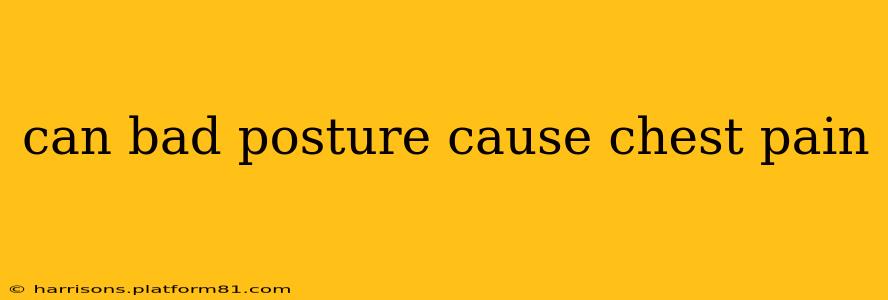Yes, bad posture can absolutely contribute to chest pain, although it's rarely the sole cause of significant chest pain. It's crucial to understand that chest pain can be a symptom of serious heart conditions, so if you experience persistent or severe chest pain, you should always seek immediate medical attention. This article explores the connection between posture and chest pain, clarifying when it's likely a contributing factor and when it warrants a trip to the doctor.
How Does Bad Posture Lead to Chest Pain?
Poor posture, particularly slouching or hunching, can affect several areas that might indirectly cause or exacerbate chest pain. These include:
-
Muscle Strain and Tension: When you slouch, your chest muscles become shortened and tight, while your back muscles are stretched and weakened. This imbalance can lead to muscle strain and tension in the chest, shoulders, and upper back, resulting in pain that can be felt in the chest area. This pain might be dull, aching, and localized, or it could radiate to other areas.
-
Restricted Breathing: Poor posture can restrict your lung capacity, making it harder to breathe deeply. Shallow breathing can lead to discomfort in the chest, as well as feelings of shortness of breath and tightness. This is often misinterpreted as chest pain.
-
Increased Pressure on Nerves and Organs: Slouching puts pressure on the nerves and organs in your chest cavity. This pressure can cause referred pain—pain felt in one area but originating from another. The discomfort might manifest as a dull ache or sharp pain in the chest.
-
Rib Cage Restriction: Chronic poor posture can lead to a restricted rib cage, limiting its ability to expand and contract properly during breathing. This restriction can trigger muscular pain in the intercostal muscles (between the ribs) and cause discomfort in the chest area.
-
Increased Stress Levels: While not directly causing physical chest pain, poor posture is often associated with stress and anxiety, which can contribute to or worsen existing chest pain. This psychosomatic connection is significant and should not be overlooked.
What Kind of Chest Pain is Related to Posture?
Chest pain linked to poor posture is typically:
- Dull and Aching: It's not usually sharp or stabbing like the pain associated with a heart attack.
- Localized or Radiating: The pain may be concentrated in the chest or radiate to the shoulders, neck, or upper back.
- Worsened by Posture: The pain intensifies when you slouch or maintain poor posture for extended periods.
- Relieved by Posture Correction: Adopting good posture, stretching, and gentle exercise can often alleviate the pain.
When Should I See a Doctor About Chest Pain?
Always seek immediate medical attention if your chest pain is:
- Severe or Sudden: Especially if accompanied by shortness of breath, sweating, or nausea.
- Associated with other symptoms: Such as dizziness, lightheadedness, or jaw pain.
- Persistent or worsening: If the pain doesn't improve with rest and posture correction.
Can Chiropractic Care Help with Posture-Related Chest Pain?
Chiropractic care often focuses on correcting spinal alignment and improving posture. A chiropractor may use adjustments, stretches, and exercises to address muscle imbalances, improve joint mobility, and reduce pressure on nerves. This approach can be beneficial for alleviating posture-related chest pain.
What Exercises Can Help Improve Posture and Reduce Chest Pain?
Regular exercise focusing on strengthening your back and core muscles and stretching your chest muscles is crucial for improving posture. Simple exercises like:
- Chest stretches: These help to lengthen tight chest muscles.
- Back extensions: These strengthen back muscles, supporting better posture.
- Plank exercises: These strengthen the core, improving overall stability and posture.
These, alongside regular mindful posture checks, can significantly reduce or eliminate posture-related chest pain. Always consult with a healthcare professional before starting any new exercise regimen.
In Conclusion
While poor posture can contribute to chest pain, it's essential to distinguish it from chest pain stemming from more serious medical conditions. If you're experiencing chest pain, especially if it's severe or accompanied by other symptoms, seek immediate medical attention. However, if your chest pain is mild, dull, and seems related to your posture, improving your posture through exercises and stretches can help alleviate the discomfort. Remember, preventative measures like maintaining good posture are essential for overall health and well-being.
